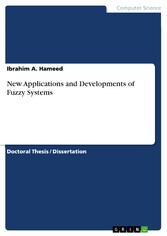Suchen und Finden
New Applications and Developments of Fuzzy Systems
Doctoral Thesis / Dissertation from the year 2010 in the subject Computer Sciences - Artificial Intelligence, grade: PhD, Korea University, Seoul (College of Engineering - Dept of Industrial Systems and Information Engineering), course: Intelligence Control and Artificial Intelligence, language: English, abstract: Fuzzy Logic (FL) is a particular area of interest in the study of Artificial intelligence (AI) based on the idea that in fuzzy sets each element in the set can assume a value from 0 to 1, not just 0 or 1, as in classic or crisp set theory. The gradation in the extent to which an element is belonging to the relevant sets is called the degree of membership. This degree of membership is a measure of the element's belonging to the set, and thus of the precision with which it explains the phenomenon being evaluated. A linguistic expression is given to each fuzzy set. The information contents of the fuzzy rules are then used to infer the output using a suitable inference engine. The key contribution of fuzzy logic in computation of information described in natural language made it applicable to a variety of applications and problem domains; from simple control systems to human decision support systems. Yet, despite its long-standing origins, it is a relatively new field, and as such leaves much room for development. The thesis presents two novel applications of fuzzy systems; a human decision support system to help teachers to fairly evaluate students and two hybrid intelligent fuzzy systems; a type-2 fuzzy logic system and a combined type-1 fuzzy logic system and extended Kalamn filter for controlling systems operating under high levels of uncertainties due to various sources of measurement and modeling errors. The combination of fuzzy logic and the classical student evaluation approach produces easy to understand transparent decision model that can be easily understood by students and teachers alike. The developed architecture overcomes the problem of ranking students with the same score. It also incorporated different dimensions of evaluation by considering subjective factors such as difficulty, complexity and importance of the questions. Although we discuss this approach with an example from the area of student evaluation, this method evidently has wide applications in other areas of decision making including student's project evaluation, learning management systems evaluation, as well as, other assessment applications. [...]
Alle Preise verstehen sich inklusive der gesetzlichen MwSt.







